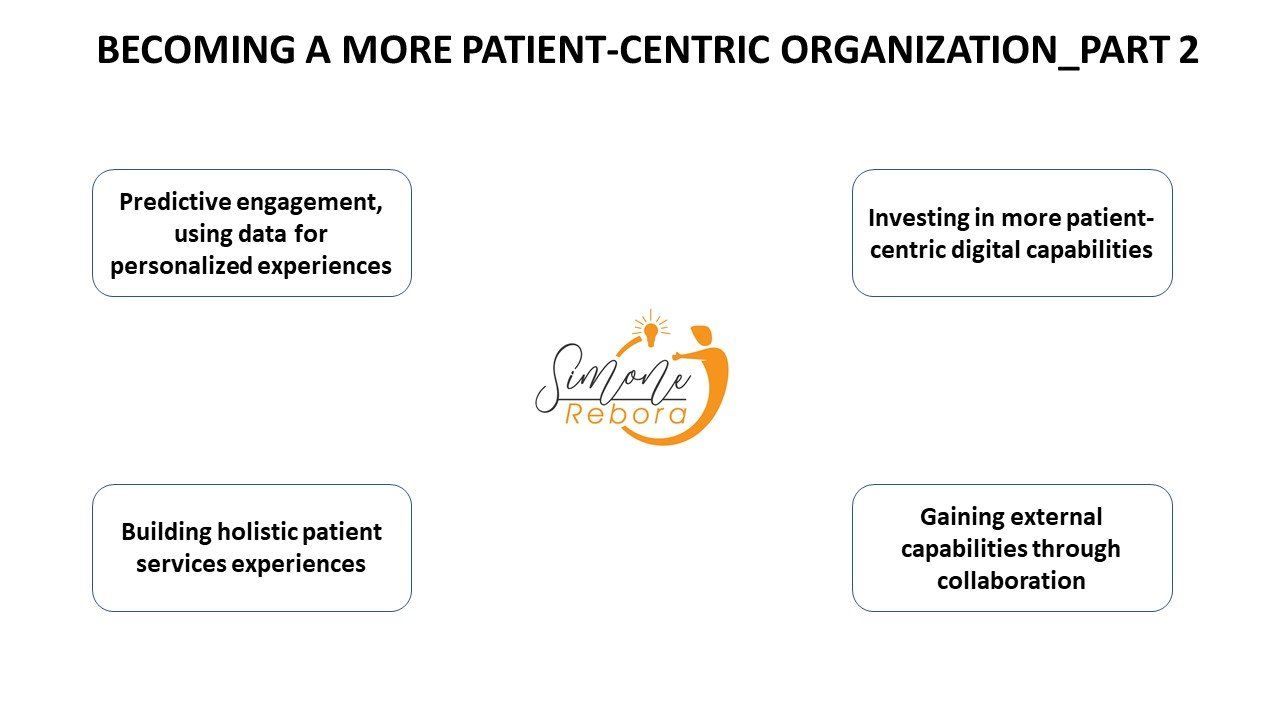EVOLUTION OF THE PATIENT'S EXPERIENCE-PART 2
A first-class customer service experience has as goal to ‘delight’ customers by anticipating the unexpressed wishes of their guests. Customer data is used to shape a personalized experience, and an innovation database stores ideas to share across properties

Predictive engagement, using data for personalized experiences
Anticipating needs and meeting expectations
Transforming clinical trials and patient services often requires catching up with other patient experiences. Patients have expectations that they may not even be aware of, shaped from previous experiences. For example, when someone has a great customer service experience in retail or online, they expect the same from their health care app, website, or consultation.
A first-class customer service experience has as goal to ‘delight’ customers by anticipating the unexpressed wishes of their guests. Customer data is used to shape a personalized experience, and an innovation database stores ideas to share across properties.
In health care, we can enjoy this mental attitude and anticipate adverse health events by using data and digital tools to predict and prevent, as for instance algorithms which may predict who is likely to have a second heart attack, and companies can work
with patients to prevent it.
Enhancing engagement with leading-edge technology
Healthcare companies can drive purposeful and meaningful digital innovation by creating precision experiences with leading-edge
Technology, leveraging on AI-driven engagement, connecting patient, and using health care provider (HCP) platforms that can provide
patients and partners timely access to content and treatments that are relevant and personalized:
360-degree view of patients and partners (cloud/data lakes)
• By combing behavioural and socioeconomic patient data with marketing data (interactions with online ads, impressions,
conversions) in data lakes or the Cloud, companies create 360-degree view of patient behaviour across digital and physical footprints.
• Similarly, data on how physicians interact with the company and affiliate web ads, email, and social media content is aggregated to provide a view of their engagement across channels and platforms and can be cross-referenced to specific patients.
Al-based engagement recommendations (Al)
• AI marketing solutions analyze patient datasets to recommend how, when, and with what customized content to engage patients and partners (such as personalized ads, tailored medication regimens, and adherence programs) across channels and the patient journey.
Next gen HCP portals (chatbots)
• Next generation HCP portals and AI chatbots enable on-demand access to information and seeking peer opinion to improve care delivery, while broadening access opportunities for companies.
Connected patient platforms (cloud/wearables)
• Cloud-based connected patient platforms aggregate data from patient wearables and medical devices , track and analyze patient outcomes, and link patients to physicians and support groups to create longitudinal engagement.
Proactive market intelligence (Al/cloud)
• Al enables curation and analysis of unique information sources to sense changes in the marketplace (such as likely changes to reimbursement practices, regulations, competitor tactics) that could affect launch strategies and competitive dynamics
Investing in more patient-centric digital capabilities
Digital becoming a strategic priority
Digital health, digital medicine, and digital therapeutics offer life sciences and stakeholders an opportunity to create more
personalized experiences and new ways to become a patient-centric company. In the coming year, life science and medtech companies
plan to grow investments in digital skills for more personalized therapies and patient support.
In accordance with a recent study by Deloitte, executives from life sciences, technology, payer, and provider organizations expect
digital medicine products to become a strategic priority. Specifically, digital therapeutics are starting to impact patient
outcomes and show clinical validation. The need for education around these solutions is intensifying daily. If physicians are not educated on what digital therapeutics can acheive and how they may help patients, they are unlikely to prescribe them. Staying up to date on regulations, the types of solutions available, clinical applications, digital biomarkers, etc. will remain an on-going need as technology evolves exponentially. Here below some practical examples:
Digital Health. Digital health includes technologies, platforms, and systems that engage consumers for lifestyle, wellness, and health-related purposes; capture, store or transmit health data; and/or support life science & clinical operations.
Digital Medicine. Digital medicine includes evidence-based software and/or hardware products that measure and/or intervene in the services of human health.
Digital Therapeutics Digital therapeutic (DTx) products deliver evidence based therapeutic interventions to prevent, manage, or treat a medical disorder or disease.
Building holistic patient services experiences
Developing patient services in-house
Life sciences companies typically manage patient services programs by therapy or therapeutic area. As patient engagement
becomes more comprehensive, an increasing number of healthcare companies are moving patient services in-house. An important first step to proving value for an in-house platform is starting small—with one or a limited number of therapies.
Operationalizing a patient services program and moving it in-house requires integrating with internal and external systems
and refining operations and processes. Service offerings should be adapted toward excellence in patient support. Innovating
means analyzing key interactions to generate strategic insights that will inform the patient journey. There are specialized solutions along the patient journey, with which companies will want to partner (vs. seek to build themselves). Services to facilitate scheduling, pharmacy e-commerce, drone distribution of medical supplies, best in class Natural Language Understanding, and the plethora of digital applications enhancing a specific touchpoint are all capabilities life sciences companies can harness and integrate to their in-house services programs.
Working with partners in the ecosystem
From my personal point of view, the partnerships across the ecosystem are also key and should be considered a must-have . When different companies deliver various parts of the journey, everyone needs to come together to create ‘one experience’ for the patient. Whether for observational studies, clinical trials, or therapy support, the patient service workflows extend beyond a single life sciences or
health care enterprise. Nowadays, there are exciting and amazing innovative solutions which drive standardization of workflows, like enrolment, benefits checks, and authorizations through a set of interfaces, leveraging data, cloud and AI. Wherever opportunity exists, these tools eliminate manual workflows through automation.
In addition, these platforms provide personalization and enable the “whenever, wherever” paradigm of patient access by
providing seamless integration of communication channels like phone calls, secure messaging, and video chats. In each
scenario —standard workflows, communication channels, or automation—the patient can benefit from these experiences, as well as companies can learn and improve day-after-day.



